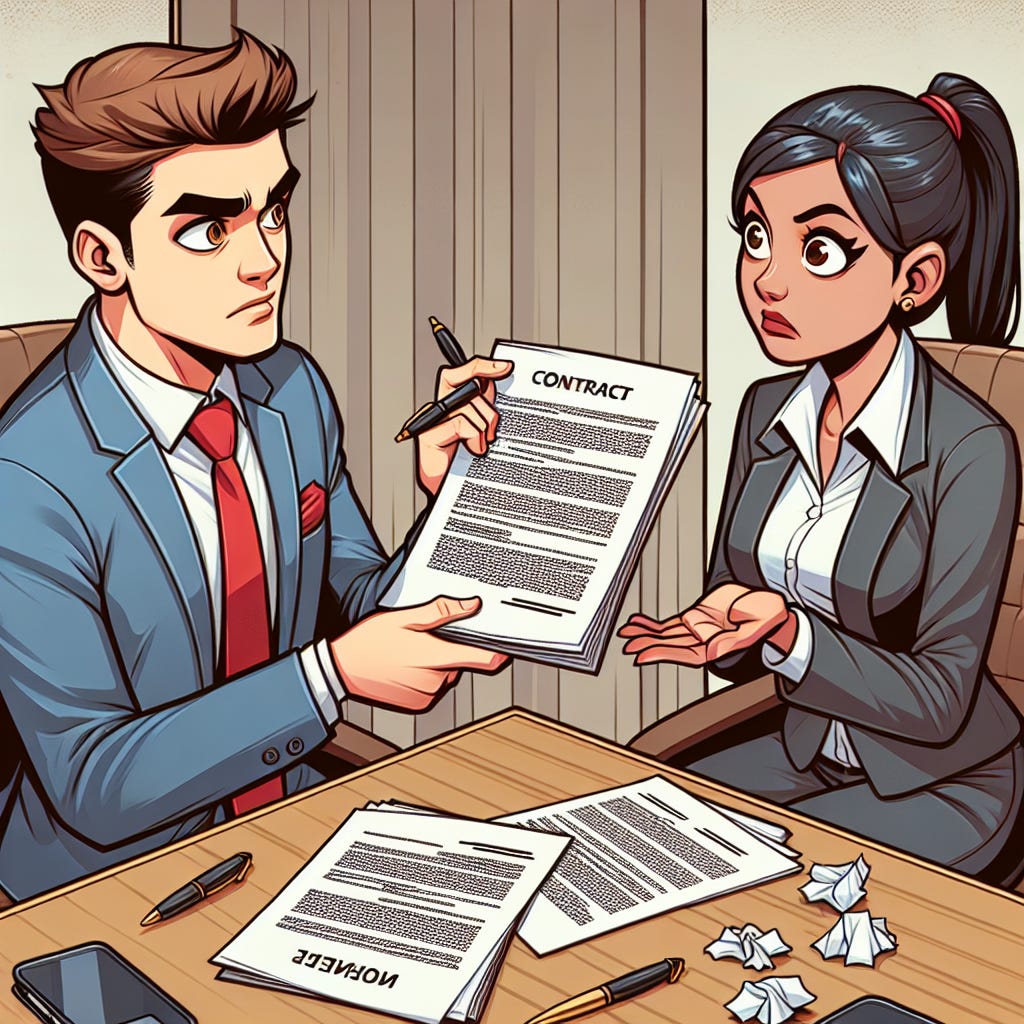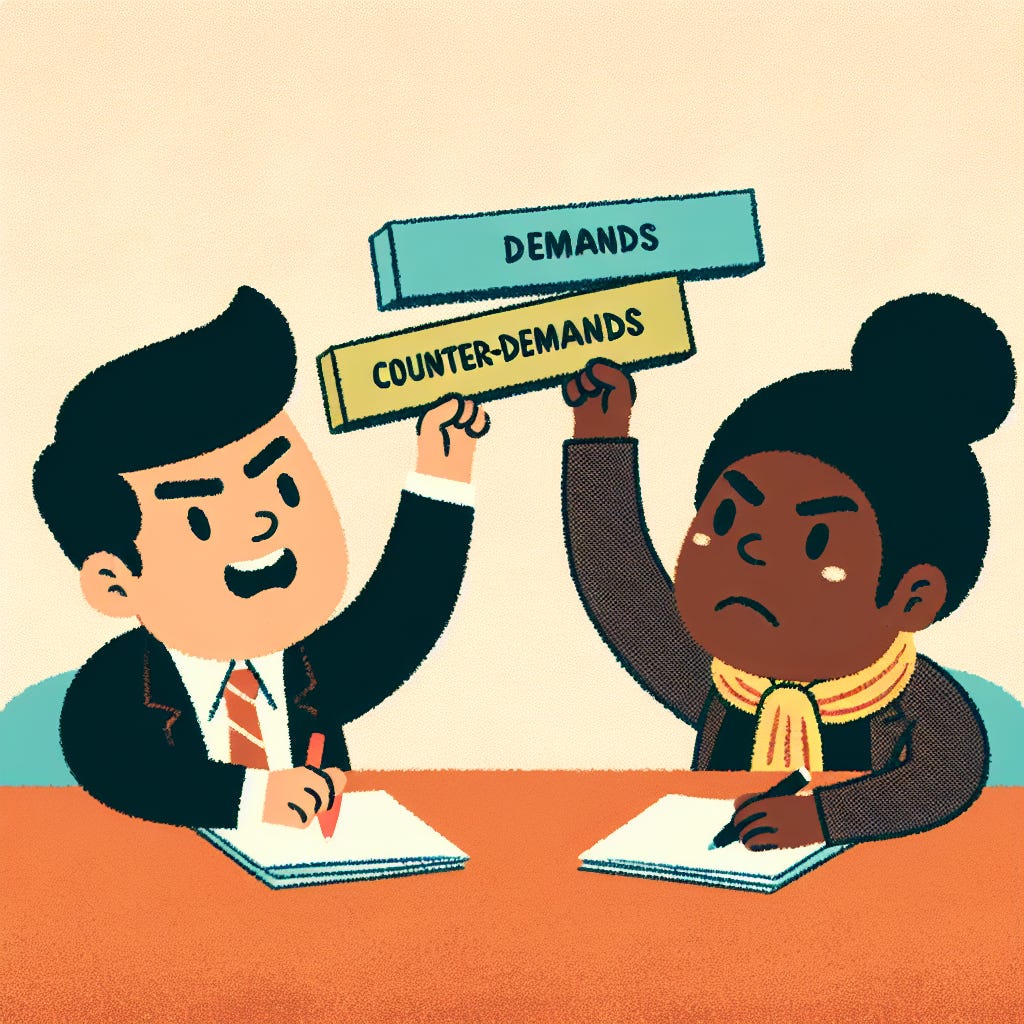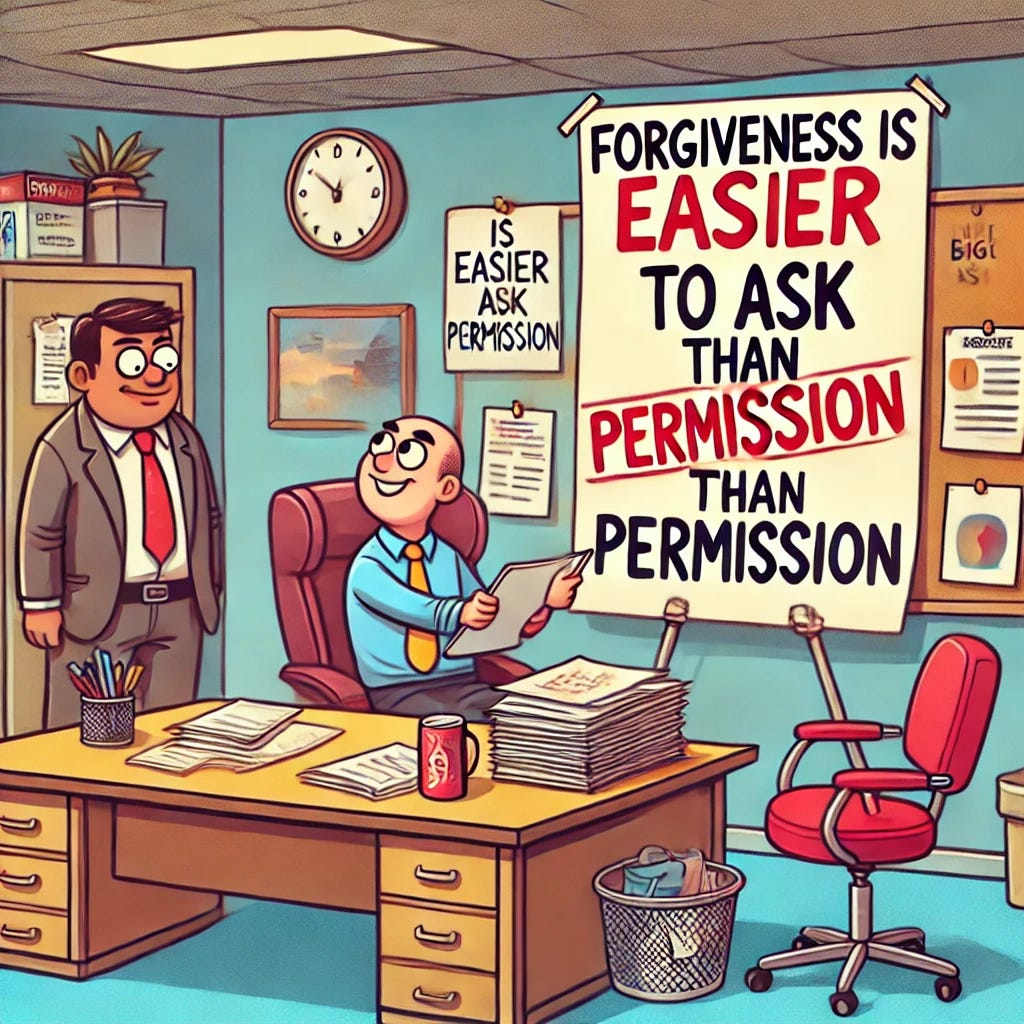High-Impact Negotiation Frameworks: 5/5
Pressure and Unethical Tactics - Part 5 of a Series of 5 Posts
Welcome to the final part of my series on High-Impact Negotiation Frameworks. In the previous posts, I covered foundational negotiation principles and early, middle, and end-stage tactics. Today, I will delve into pressure and unethical tactics you may encounter during negotiations. Understanding these tactics will help you recognize when they are being used against you and how to counter them effectively.
The Importance of Recognizing Pressure and Unethical Tactics
In chess, players often use pressure and misdirection to gain an advantage. Time pressure can force an opponent into making hasty decisions while creating distractions, and using behaviour to misdirect attention can lead to critical mistakes. Similarly, in negotiations, pressure and unethical tactics can be employed to manipulate the other side and gain the upper hand. Recognizing these tactics is crucial for maintaining your position and negotiating effectively. Just as in chess, where you must anticipate and counter your opponent's moves, in negotiations, you must be prepared to identify and counter these tactics to protect your interests and achieve a favourable outcome.
Unethical Negotiating Tactics
Unethical Tactic 1: The Decoy
The Decoy tactic diverts your attention away from the real issue in the negotiation. This can be done by creating a false issue that seems important but is irrelevant to the core of the negotiation.
Detailed Strategies and Tactics:
Identify the Decoy: The first step is recognising when a decoy is used. This involves paying close attention to the issues raised and determining if they are relevant to the core negotiation.
Stay Focused: Maintain focus on the primary issues. When a decoy is introduced, acknowledge it but steer the conversation back to the main points.
Isolate the Objection: Ask questions to isolate the objection. For example, "Is this the only issue bothering you?" This helps identify whether the decoy is a real concern or a distraction.
Use Higher Authority: Respond by saying, "Let's get something in writing, and I'll take it to my people and see what I can do for you with them." This buys you time and shifts the focus back to the main negotiation.
Turn the Tables: Offer a trade-off. For instance, "We may be able to accelerate the shipment, but it's going to increase the non-recurring engineering charges."
Example: Imagine you are negotiating a contract for a new software system. The vendor suddenly raises concerns about the user interface's colour scheme, making it seem significant. You realize that the real issue is the cost of customization. You can address the real issue and negotiate more effectively by acknowledging the colour scheme concern but steering the conversation back to the customization costs.
Key Points to Remember:
Watch for issues that the other side declares important.
They may be creating a decoy that they will try to trade off later for something they care about.
Don't be thrown off if they appear to be offended by a minor slight.
Stay focused and isolate the objection.
Unethical Tactic 2: The Red Herring
The Red Herring tactic involves making a phoney demand to distract you and trade it off later for a real concession. It is a more sophisticated version of the Decoy tactic.
Detailed Strategies and Tactics:
Recognize the Red Herring: Be alert to exaggerated or irrelevant demands. These are often used to distract you from the real issues.
Question the Demand: Ask open-ended questions to understand the significance of the demand. For example, "Can you explain why this is important to you?"
Stay Grounded. Focus on the primary objectives of the negotiation, and do not get sidetracked by the Red Herring.
Link to Real Issues: Try to link the Red Herring back to the main issues. For example, "How does this demand relate to our primary goal of reducing costs?"
Example: In a business negotiation, the other side might demand an unusually high level of service or an extended warranty. By questioning the demand and linking it back to the main issues, you can determine if it is a genuine concern or a Red Herring.
Key Points to Remember:
Be alert to the other side using a Red Herring.
They may create an issue that they will try to trade off later.
Keep your eye on the negotiating issues, and don't let them link the Red Herring to a concession you're reluctant to make.
Unethical Tactic 3: Cherry Picking
Cherry Picking is when a buyer uses information from various sellers to create an ideal deal and then asks one seller to match it. This can be devastating for sellers if they are not prepared.
Detailed Strategies and Tactics:
Gather Information: As a buyer, gather detailed information from multiple sellers. This includes pricing, features, warranties, and delivery times.
Create an Ideal Deal: Combine the best aspects of each seller to create an ideal deal that meets all your requirements.
Negotiate with Your Preferred Seller: Present the ideal deal to your preferred seller and ask them to match it. For example, "I like your product, but another company offers a longer warranty. Can you match that?"
Build Relationships: As a seller, build strong relationships with your buyers. Trust can mitigate the impact of cherry-picking.
Know Your Competition: Stay informed about your competitors' offerings. This allows you to counter cherry-picking by highlighting your unique advantages.
Example: A company looking to purchase office equipment might invite multiple suppliers to present their products. After gathering information, they create an ideal deal and ask their preferred supplier to match it, leveraging the best terms from all suppliers.
Key Points to Remember:
If you're the buyer, get itemized breakdowns of bids.
Try to get them to match the lowest price on each item.
If you're the seller, learn so much about your competitors that the buyer doesn't want to waste time talking to them.
Calculate the alternatives available to the other side. You have power in a negotiation when you have more alternatives than they do.
Unethical Tactic 4: The Deliberate Mistake
The Deliberate Mistake involves making a mistake in the proposal to bait the other side into thinking they can take advantage of it.
Detailed Strategies and Tactics:
Identify the Mistake: Be vigilant in reviewing proposals and contracts to spot any deliberate mistakes.
Clarify the Terms: If you find a mistake, clarify it with the other side. For example, "I noticed that the price for the additional feature is not included. Can we discuss this?"
Avoid Greed: Do not try to take advantage of the mistake. This can backfire and lead to a loss of trust.
Use Ethical Practices: Always aim for transparency and honesty in negotiations. This builds long-term relationships.
Example: A car salesperson might "forget" to include the cost of a premium sound system in the proposal. If the buyer points out the mistake, the salesperson can correct it or use it to pressure the buyer into closing the deal quickly.
Key Points to Remember:
Never try to get away with anything. If your greed doesn't cost you at that moment, it will catch up with you later.
Point out the mistake and clarify the terms.
Unethical Tactic 5: The Default
The Default tactic involves making a unilateral assumption that works to the advantage of the side proposing it.
Detailed Strategies and Tactics:
Recognize the Default: Be aware of any unilateral assumptions made by the other side. For example, "We assume you will accept a 2% discount for early payment."
Challenge the Assumption: Politely challenge the assumption and clarify your position. For example, "We have not agreed to a 2% discount. Please remit the full amount."
Communicate Clearly: Ensure both parties agree upon all terms and conditions.
Example: A company might send an invoice with a 2% discount for early payment, assuming the vendor will accept it. If the vendor challenges this assumption, the company must remit the full amount.
Key Points to Remember:
Call the other side and explain that you expect more ethics from them.
Communicate your disappointment and request the balance or correction.
Unethical Tactic 6: Escalation
Escalation involves raising demands after both sides have reached an agreement. This can create significant frustration and distrust.
Detailed Strategies and Tactics:
Protect with Higher Authority: Use higher authority to protect yourself. For example, "My board of directors will never renegotiate a deal once it has been made."
Offer Value in Other Areas: If you cannot budge on the main issue, offer something of value in another area. For example, "We cannot change the price, but we can offer extended support."
Escalate in Return: If the other side escalates their demands, respond by escalating yours. For example, "Since you want to renegotiate, our price has also increased."
Tie-Up Details Up Front: Avoid escalation by tying up all details upfront. Do not leave anything to "we can work that out later."
Example: After agreeing on the price of a service contract, the client demands additional services at no extra cost. By using higher authority and offering value in another area, you can address this escalation.
Key Points to Remember:
Protect yourself with Higher Authority.
Position for Easy Acceptance by offering something of value in another area.
Escalate your demands in return if necessary.
Tie up all the details upfront to avoid Escalation.
Unethical Tactic 7: Planted Information
Planted Information involves providing false or misleading information to influence the other side's decisions.
Detailed Strategies and Tactics:
Verify Information: Always verify information from multiple sources. Do not rely solely on what the other side provides.
Be Skeptical: Maintain a healthy level of scepticism, especially if the information seems too good to be true.
Ask Clarifying Questions: Ask questions to clarify and validate the information. For example, "Can you provide more details on this offer?"
Example: A salesperson might plant a note indicating a competitor's lower price to pressure you into accepting their offer. You can avoid falling into this trap by verifying the information and asking clarifying questions.
Key Points to Remember:
Be vigilant and aware of the possibility of planted information.
Verify information from multiple sources.
Pressure Tactics
Pressure Tactic 1: Time Pressure
Time Pressure involves creating a sense of urgency to force the other side to make concessions.
Detailed Strategies and Tactics:
Create Urgency: Use deadlines and time constraints to create a sense of urgency. For example, "This offer is only valid for 24 hours."
Avoid Revealing Your Deadline: Never reveal your deadline. This keeps the other side guessing and maintains your leverage.
Identify Their Deadline: Establish if the other side has a deadline. This can give you an advantage in negotiations.
Use Acceptance Time: Leave your initial proposal on the table long enough for the other side to accept it. They may eventually find it acceptable.
Example: In a real estate negotiation, you might tell the seller, "We need to close this deal by the end of the month to secure financing." This creates urgency and can lead to concessions from the seller.
Key Points to Remember:
Eighty per cent of concessions occur in the last 20% of available time.
Tie up all the details upfront.
People become flexible under time pressure.
Never reveal that you have a deadline.
Try to establish that the other side has a deadline.
The more powerful side should use time pressure in situations with mutual deadlines.
Power is directly related to the number of options each side has.
Allow acceptance time for the other side to accept less than they initially wanted.
Pressure Tactic 2: Information Power
Information Power involves gathering and using information to your advantage in negotiations.
Detailed Strategies and Tactics:
Admit When You Don't Know: Don't be afraid to admit you don't know something. This can prompt the other side to provide more information.
Ask Tough Questions: Be a good reporter and ask tough questions. Even if they don't answer, you may gain valuable insights.
Gather Comprehensive Information: Collect information from multiple sources, not just your negotiation partner.
Use Open-Ended Questions: Ask questions that cannot be answered with a simple yes or no. For example, "What are your main concerns with this proposal?"
Example: In a salary negotiation, ask questions like, "What is the typical salary range for this position in the industry?" This helps you gather information to make a stronger case for your desired salary.
Key Points to Remember:
Good information gathering is essential for successful negotiations.
Don't be afraid to admit you don't know.
Be a good reporter: Ask tough questions.
Don't assume you know what the other side wants—get them to tell you.
Ask open-ended questions that can't be answered by a simple yes or no.
Be cautious about using "why" questions.
Repeat the question to clarify.
Ask for feelings, reactions, and restatements.
Don't rely solely on information given by the other side.
People share information more readily away from their workplace.
Use peer group information-gathering techniques.
Pressure Tactic 3: Being Prepared to Walk Away
Being Prepared to Walk Away involves having the power to leave the negotiation if necessary.
Detailed Strategies and Tactics:
Develop Walk-Away Power: Increase your alternatives before negotiating. The side with the most options has the most power.
Communicate Subtly: Subtly communicate to the other side that you are prepared to walk away. This can create pressure without confrontation.
Use Higher Authority: Protect yourself with higher authority. For example, "My manager insists on these terms, and I cannot agree without their approval."
Example: In a business deal, you might say, "We have other potential partners interested in this project. If we cannot agree, we may need to explore those options." This communicates your willingness to walk away and can lead to concessions from the other side.
Key Points to Remember:
Always project that you are prepared to walk away.
Once you project you won't walk away, you lose your options and power.
Selling is a four-step process: prospecting, qualifying, desire building, and closing.
The objective is not to walk away but to get concessions because the other side believes you will walk away.
Protect yourself with good guy/bad guy tactics.
Develop walk-away power by having options before negotiating.
Communicate subtly that you are prepared to walk away.
Pressure Tactic 4: Take It or Leave It
Take It or Leave It creates a win-lose situation and should be used cautiously.
Detailed Strategies and Tactics:
Avoid Using the Expression: Avoid using the expression "Take it or leave it" as it makes people dig in their heels.
Use Higher Authority: Use higher authority to apply pressure without confrontation. For example, "I would love to agree, but my manager insists on these terms."
Respond Tactfully: When faced with a take-it-or-leave-it situation, respond by calling their bluff, tactfully going over their head, or finding a face-saving way for them to modify their position.
Example: In a supplier negotiation, the supplier might say, "This is our final offer. Take it or leave it." You can respond by saying, "I understand your position, but my manager insists on a lower price. Can we find a middle ground?"
Key Points to Remember:
Avoid using the expression "Take it or leave it", as it makes people dig in their heels.
Use higher authority to put pressure without confrontation.
Respond to a take-it-or-leave-it attitude by calling a bluff, tactfully going over their head, or finding a face-saving way for them to modify their position.
Pressure Tactic 5: The Fait Accompli
The Fait Accompli assumes the other side agrees without asking for permission. Many times, forgiveness is easier to obtain than permission. Inertia prevents a negotiator from renegotiating for a minor reach.
Detailed Strategies and Tactics:
Assume Agreement: Present your proposal as if the other side has already agreed. For example, "I have prepared the contract based on our previous discussions."
Make Changes if Necessary: If you disagree with any points in a contract, make changes and send the corrected contract back. They may accept the changes rather than reopen negotiations.
Use Cautiously: Don't use this tactic if concerned about the other side's reaction. It can backfire if they feel manipulated.
Example: A contractor might send an invoice without an estimate, assuming the client agrees to the charges. If the client disagrees, they can make changes and return the corrected invoice.
Key Points to Remember:
If you disagree with any points in a contract, make changes and return the corrected contract.
Don't use this tactic if you're concerned about the other side's reaction.
Pressure Tactic 6: The Hot Potato
The Hot Potato involves making your problem the other side's problem.
Detailed Strategies and Tactics:
Test for Validity: When someone tries to make their problem your problem, test for validity. For example, "If I could show you a solution that meets your needs, would you be interested?"
Ask Clarifying Questions: Ask questions to understand the real issue. For example, "When does your budget year end?" or "Is there another budget this could fit into?"
Avoid Accepting Their Problem: Be cautious about accepting their problem as your own. Focus on finding mutually beneficial solutions.
Example: A client might say, "We don't have the budget for this project." You can respond by asking, "When does your budget year end?" or "Is there another budget this could fit into?" This helps to test the validity of their claim and find a solution.
Key Points to Remember:
Beware of other people giving you their problems.
Test for validity when they do this. Is it a deal killer?
Don't buy their procedural or bureaucratic issues. If they don't have it in the budget, they can change it.
Conclusion
Understanding and recognizing pressure and unethical tactics are crucial for successful negotiations. By being aware of these tactics and knowing how to counter them, you can protect your interests and achieve favourable outcomes. Whether dealing with time pressure, information power, or unethical tactics like the Decoy or Red Herring, staying vigilant and prepared will help you navigate even the most challenging negotiations.
Summary of Articles 1-4
Article 1: Foundational Principles
Get the Other Side to Commit First
Acting Dumb Is Smart
Don't Let the Other Side Write the Contract
Read the Contract Every Time
Understand and Decode Funny Money
People Believe What They See in Writing
Concentrate on the Issues
Always Congratulate the Other Side
Article 2: Early-Stage Tactics
Ask for More Than You Expect to Get
Never Say Yes to the First Offer
Flinch at Proposals
Avoid Confrontational Negotiation
The Reluctant Seller and the Reluctant Buyer
Article 3: Middle-Stage Tactics
The Vise Technique
Handling the Person Who Has No Authority to Decide
The Declining Value of Services
Never Offer to Split the Difference
Handling Impasses
Handling Stalemates
Handling Deadlocks
Always Ask for a Trade-off
Article 4: End-Stage Tactics
Good Guy/Bad Guy
Nibbling
How to Taper Concessions
The Withdrawing an Offer Tactic
Positioning for Easy Acceptance
Giving Something Back
Additional Insights and Examples
To further illustrate the application of these tactics, let's explore additional real-life scenarios and insights that can help you become a more effective negotiator.
Scenario 1: Real Estate Negotiation
Imagine you are negotiating the purchase of a commercial property. The seller initially offered the property at 1 million. You decide to use the Decoy tactic by focusing on the property's relatively high maintenance costs. You express concern over these costs and suggest a lower purchase price would help offset them. By diverting attention to the maintenance costs, you create leverage to negotiate a better deal on the purchase price.
Scenario 2: Salary Negotiation
You are negotiating a salary increase with your employer. Instead of directly asking for a higher salary, you use the Red Herring tactic by emphasizing the need for additional benefits, such as flexible working hours or vacation days. This distracts the employer from the salary discussion, and you can later trade off these demands for a higher salary.
Scenario 3: Vendor Contract
In a vendor contract negotiation, the vendor uses the Cherry Picking tactic by presenting various options with different pricing and features. As a buyer, you gather detailed information from multiple vendors and create an ideal deal that combines the best features and pricing. You then present this ideal deal to your preferred vendor and ask them to match it. By leveraging the information gathered, you secure the best possible terms.
Scenario 4: Service Agreement
You are negotiating a service agreement with a new client. The client Deliberately forgets to include the cost of additional services in the proposal. You identify the mistake and clarify the terms, ensuring that all costs are accurately reflected in the agreement. This prevents the client from taking advantage of the mistake and ensures transparency.
Scenario 5: Product Purchase
In a product purchase negotiation, the seller uses the Default tactic by assuming you will accept a 2% discount for early payment. You challenge this assumption and clarify that you disagreed with the discount. By addressing the assumption early, you ensure that the terms are clear and mutually agreed upon.
Scenario 6: Project Negotiation
You are negotiating a project contract with a client. After reaching an agreement, the client uses the Escalation tactic by demanding additional services at no extra cost. You protect yourself with higher authority by stating that your board of directors will not renegotiate the deal. You offer value in another area, such as extended support, to address this escalation without compromising the original terms.
Scenario 7: Competitive Bid
In a competitive bid situation, a competitor uses Planted Information to influence your pricing decisions. They plant a note indicating a lower bid from another company. You verify the information from multiple sources and ask clarifying questions to ensure accuracy. By doing so, you avoid making decisions based on false information and maintain your competitive edge.
Practical Tips for Effective Negotiation
To further enhance your negotiation skills, consider the following practical tips:
Prepare Thoroughly: Before entering a negotiation, gather all relevant information and prepare your strategy. Understand the other side's needs and interests and anticipate potential objections.
Build Rapport: Establish a positive relationship with the other side. Building rapport can create a collaborative atmosphere and facilitate smoother negotiations.
Listen Actively: Pay close attention to what the other side is saying. Active listening helps you understand their needs and concerns, allowing you to address them effectively.
Be Patient: Negotiations can take time. Avoid rushing the process. Allow time for the other side to consider your proposals and respond thoughtfully.
Stay Flexible: Be open to alternative solutions and compromises. Flexibility can help you find mutually beneficial outcomes and build long-term relationships.
Maintain Professionalism: Always conduct yourself professionally, even in challenging situations. Professionalism fosters respect and trust, which are essential for successful negotiations.
Use Silence Strategically: Silence can be a powerful tool in negotiations. After making a proposal or counteroffer, remain silent and allow the other side to respond. Silence can create pressure and prompt concessions.
Document Agreements: Ensure that all agreements are documented in writing. Written agreements provide clarity and serve as a reference in case of disputes.
Practice Ethical Negotiation: Uphold ethical standards in all negotiations. Ethical negotiation builds trust, maintains your reputation, and leads to sustainable agreements.
Seek Win-Win Solutions: Aim for solutions that benefit both parties. Win-win solutions create positive relationships and increase the likelihood of future collaborations. Once the negotiation is done, leave a bit extra on the table - a bit more than you need to or is expected. Delight your partners and build lifelong trust and relationships.
Conclusion
I learned a valuable lesson with a partner in China that forever changed my approach to negotiation. We were discussing the concept of win-win negotiation, and he said, "That's impossible. There is no win-win. Who will win first?"
He taught me that the essence of negotiation is, "We both win, but I help you to win first."
This profound insight encapsulates the most important secret of high-impact negotiation: creating a framework where both sides believe they have won something, leave the negotiation prepared to make the agreement succeed, and foster goodwill for future interactions. Life is long and circular; if you 'defeat' someone in a negotiation, you will likely be defeated the next time you negotiate with them.
Negotiation is an art and a science that requires a combination of knowledge, skills, and strategies. You can navigate negotiations effectively and achieve favourable outcomes by understanding and recognising pressure and unethical tactics. Throughout this series, we have explored foundational principles, early-stage tactics, middle-stage tactics, end-stage tactics, and pressure and unethical tactics. Each of these components plays a crucial role in the negotiation process.
I hope this series has provided valuable insights and practical strategies to enhance your negotiation skills. Remember, successful negotiation is not just about winning; it's about creating value, building relationships, and achieving mutually beneficial outcomes.
Thank you for following this series, and I wish you success in all your future negotiations.
Sources
These frameworks have been developed and honed through real-life experience negotiating across markets and industries. They have been informed by various training programs and books - chiefly Roger Dawson's amazing 'Secrets of Power Negotiating', "You Can Negotiate Anything" by Herb Cohen, and "Getting to Yes: Negotiating Agreement Without Giving In" by Roger Fisher, William Ury, and Bruce Patton.
If you found this post valuable, please share it with others
Check out some of my other Frameworks on the Fast Frameworks Substack:
High-impact negotiation frameworks 4/5 - end-stage tactics
High-impact negotiation frameworks 3/5 - middle-stage tactics
High-impact negotiation frameworks 2/5 - early-stage tactics
High-impact negotiation frameworks 1/5 - Negotiating principles
Milestone 53 - reflections on completing 66% of the journey
The exponential growth framework
Fast Frameworks: A.I. Tools - Chatbots
Video: A.I. Frameworks by Aditya Sehgal
The job satisfaction framework
Fast Frameworks - A.I. Tools - Suno.AI
The Set Point Framework for Habit Change
The Plants Vs Buildings Framework
Spatial computing - a game changer with the Vision Pro
The 'magic' Framework for unfair advantage

















